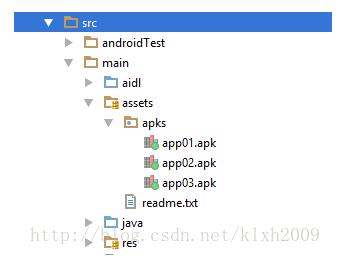Assets文件介绍 assets文件夹里面的文件都是保持原始的文件格式,需要用AssetManager以字节流的形式读取文件。 1. 先在Activity里面调用getAssets() 来获取AssetManager引用。 2. 再用AssetManager的o
Assets文件介绍
assets文件夹里面的文件都是保持原始的文件格式,需要用AssetManager以字节流的形式读取文件。
1. 先在Activity里面调用getAssets() 来获取AssetManager引用。
2. 再用AssetManager的open(String fileName, int accessMode) 方法则指定读取的文件以及访问模式就能得到输入流InputStream。
3. 然后就是用已经open file 的inputStream读取文件,读取完成后记得inputStream.close() 。
4. 调用AssetManager.close() 关闭AssetManager。
封装类
代码遵循单例模式,例如:
import android.content.Context;
import android.os.Environment;
import android.os.Handler;
import android.os.Looper;
import android.os.Message;
import java.io.File;
import java.io.FileOutputStream;
import java.io.InputStream;
/**
* Created by shenhua on 1/17/2017.
* Email shenhuanet@126.com
*/
public class FileUtils {
private static FileUtils instance;
private static final int SUCCESS = 1;
private static final int FAILED = 0;
private Context context;
private FileOperateCallback callback;
private volatile boolean isSuccess;
private String errorStr;
public static FileUtils getInstance(Context context) {
if (instance == null)
instance = new FileUtils(context);
return instance;
}
private FileUtils(Context context) {
this.context = context;
}
private Handler handler = new Handler(Looper.getMainLooper()) {
@Override
public void handleMessage(Message msg) {
super.handleMessage(msg);
if (callback != null) {
if (msg.what == SUCCESS) {
callback.onSuccess();
}
if (msg.what == FAILED) {
callback.onFailed(msg.obj.toString());
}
}
}
};
public FileUtils copyAssetsToSD(final String srcPath, final String sdPath) {
new Thread(new Runnable() {
@Override
public void run() {
copyAssetsToDst(context, srcPath, sdPath);
if (isSuccess)
handler.obtainMessage(SUCCESS).sendToTarget();
else
handler.obtainMessage(FAILED, errorStr).sendToTarget();
}
}).start();
return this;
}
public void setFileOperateCallback(FileOperateCallback callback) {
this.callback = callback;
}
private void copyAssetsToDst(Context context, String srcPath, String dstPath) {
try {
String fileNames[] = context.getAssets().list(srcPath);
if (fileNames.length > 0) {
File file = new File(Environment.getExternalStorageDirectory(), dstPath);
if (!file.exists()) file.mkdirs();
for (String fileName : fileNames) {
if (!srcPath.equals("")) { // assets 文件夹下的目录
copyAssetsToDst(context, srcPath + File.separator + fileName, dstPath + File.separator + fileName);
} else { // assets 文件夹
copyAssetsToDst(context, fileName, dstPath + File.separator + fileName);
}
}
} else {
File outFile = new File(Environment.getExternalStorageDirectory(), dstPath);
InputStream is = context.getAssets().open(srcPath);
FileOutputStream fos = new FileOutputStream(outFile);
byte[] buffer = new byte[1024];
int byteCount;
while ((byteCount = is.read(buffer)) != -1) {
fos.write(buffer, 0, byteCount);
}
fos.flush();
is.close();
fos.close();
}
isSuccess = true;
} catch (Exception e) {
e.printStackTrace();
errorStr = e.getMessage();
isSuccess = false;
}
}
public interface FileOperateCallback {
void onSuccess();
void onFailed(String error);
}
}
调用代码
如果你需要将如图所示的apks下的文件复制到SD卡的app/apks目录下,则这样调用:

FileUtils.getInstance(Context context).copyAssetsToSD("apks","app/apks");
###如果你需要收到文件复制完成的时的回调,则使用如下代码:
FileUtils.getInstance(Context context).copyAssetsToSD("apks","app/apks").setFileOperateCallback(new FileUtils.FileOperateCallback() {
@Override
public void onSuccess() {
// TODO: 文件复制成功时,主线程回调
}
@Override
public void onFailed(String error) {
// TODO: 文件复制失败时,主线程回调
}
});
代码说明
在上面代码中,通过单例模式传入一个context获得FileUtils实例,通过实例去调用copyAssetsToSD()方法,方法参数:
- String srcPath 传入assets文件夹下的某个文件夹名,如上述apks,可传入为空”“字符,则复制到SD后,默认将assets文件夹下所有文件复制;
- String sdPath 传入你希望将文件复制到的位置,如SD卡下的“abc”文件夹,则传入”abc”
以上就是本文的全部内容,希望对大家的学习有所帮助,也希望大家多多支持自由互联。
